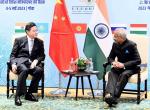The recent unfolding of events in West Asia, where the Islamic State of Syria and Iraq (ISIS) militants captured two strategically and historically important places, has once again showed its intent to consolidate, control and expand its territories. The fall of the city of Ramadi, the capital of Anbar Province in Iraq on 17 May, and the historic city of Palmyra in Syria on 20 May happened amidst the efforts to destroy this Sunni militant group. The victory was contrary to the claim by American officials that the ISIS was on the defensive side in Iraq. By capturing these cities, with very well-planned tactics, the ISIS demonstrated its capability to operate on multiple fronts and carry out effective offensive operations.
Ramadi: A Bitter Lesson
The breakneck speed at which the cities were captured raised several questions about the fighting capability of the security forces of Iraq and the effectiveness of the United States (U.S.)-led coalition air strikes. The lack of strategy, as mentioned by President Barack Obama in August 2014 vis-à-vis the fight against IS in Syria, has become more visible as there seems to be no stoppage to the terror outfit’s forward advance. ISIS’ success in capturing Ramadi is particularly a big setback in America’s effort inside Iraq.
American forces had fought a bitter battle with the Islamist militants during 2005 and 2006 to wrest this city from their control. Further, “Anbar Province holds painful historical import for the United States as the place where nearly 1,300 Marines and soldiers died after the American-led invasion of 2003.”1 Therefore, this episode has become quite galling for the Americans.
The takeover of Ramadi did not come without major resistance. It happened after a continuous battle between ISIS militants and the Iraqi Security Force (ISF). The campaign to take control of cities began in Ramadi and nearby places such as Fallujah during the late December 2013. While the ISF retained an upper hand until recently over Ramadi, Fallujah had fallen into the hands of the extremists earlier. Since then, Ramadi was a prime target for the ISIS. On the other hand, the Iraqi army, police and Sunni militia forces continued fighting against heavily-armed extremists with very little reinforcement. In the words of an American security expert,
In the eleven months since Mosul fell, only a tiny number of new local forces have been raised in Ramadi—a weak brigade of 2,000 Federal Police and a new 1,000-strong unit of tribal paramilitaries. The army forces dotted around the city are amongst the most heavily damaged and exhausted units in Iraq. 2
Clearly the Iraqi government under Prime Minister Haider al-Abadi, had for several years, had consistently neglected both Ramadi and Anbar. Michael Knight of The Washington Institute for Near East Policy eloquently puts it:
The province was always a stronghold for powerful Sunni tribes, and Baghdad struggled to control it even under Saddam Hussein. Over the past decade, Iraq’s Shiite-led government has stacked the western defenses of Baghdad and Karbala specifically to guard against the perceived threat of attack from Anbar. At the same time, the almost complete absence of Shiite citizens in the province has given the federal government little direct stake in securing it or protecting its citizens. As a result, Baghdad has tinkered with Anbar politics like a neighbouring state, sometimes providing economic and military aid but more manipulating security appointments and meddling in local power struggles. 3
The manner in which Ramadi fell was similar to that of Mosul’s capture by the outfit last June except that there were no coalition bombings in the case of the latter. This time around, the forces of the government had to flee from their posts, abandon their weapons and the vehicles after the militants began with intensified attacks which included suicide bombings by explosives-laden cars and artillery shelling. In the words of one, “Ramadi finally cracked when struck with a hammer blow—namely, twenty-eight suicide car bombs in three days, including at least six massive fifteen-ton armed truck bombs on single attack.”4 It should be noted that these attacks happened after warnings for last few months indicating that the ISIS militants could take this city into their grips. The triumph over the state forces despite the military back-up of the Western powers highlights the extent to which the strength of this organisation has been undermined. As explained by an observer, “This defeat also sets up a dramatic conflict for Prime Minister Haider al-Abadi: He could forfeit Anbar Province to ISIS or allow Shiite militias to win the day. But that comes with a big price: sectarian conflict between Sunnis and Shias.”5 Eventually, it is a bitter lesson for everyone who wants to liberate the country from the hands of the tyrants.
Palmyra: A Significant Takeover
Even before the takeover of Ramadi sunk in, the ISIS, in a quick succession, captured the historic city of Palmyra in Syria. This victory came after the forces loyal to the Syrian President Bashar al-Assad lost out to the ISIS militants in a seven-day siege. The immediate concern out of this unfolding is the fear over the possible destruction of magnificent historical ruins. Palmyra, which was once a Silk Route hub and presently one of the most important cultural centres of the ancient world, is known for its housing of several well-preserved ruins of antiquity, including the famous Temple of Bell, whose construction dates back to the first century.
Since the beginning of this year, ISIS has started to bulldoze its way through many invaluable cultural heritage sites of Syria and Iraq. They vehemently oppose the preservation of historical ruins as they feel that these glorify idolatry. For instance, the ransacking of the central museum in Mosul and destroying the ancient Assyrian city of Nimrud in northern Iraq received a widespread international condemnation. Besides destroying archaeological sites, the outfit even burned 1,500 historic manuscripts. These attacks are anti-humanity in nature “which threatens to upend millennia of coexistence in the Middle East.”6 Destruction of these antiquities should not be seen as sporadic events but they are part of that systematic campaign taken up by the outfit to uproot the legacy of “humanity’s cultural legacy.”7 But at the same time, many of the artifacts are reportedly sold by ISIS on the black market, in European cities, to fund the organisation. This is one of the many ways their entire financial system is managed. For this purpose, churches in Iraq were often targeted, and a report in December last year estimated that “ISIS was able to collect 23 million pounds from the sale of artefacts from the Syrian city of Nabaq, which is full with Christian Collectibles.”8 The UNESCO, in late September 2014, warned about the “great danger” Iraq’s cultural heritage would face should the ISIS manage to capture them. This is not the first time lootings took place but Iraqi heritage had already suffered blows following the toppling of the Hussein regime in 2003. Now, the recurrence of these incidents and the failure to protect thousands of years old artefacts or monuments reflect the lackadaisical attitude of both Iraq and the international powers that are striving to bring stability in the region.
The loss of Palmyra to the ISIS is equally a strategic defeat as this location opens routes of further advance to other cities such as Homs and Damascus. That the outfit captured al-Hail and Arak gas fields, surrounding the ancient ruins which supply electricity to various parts in western Syria is an alarming situation. In addition to this, the key supply lines to the regime’s forces in the province of Deir Ezzor in the east has been severed, and with this, the outfit has managed to opened its doors to a possible offensive on the aforementioned two cities, which are the strongholds of the Assad regime. Another exploit inside Syria is the demolition of the infamous Tadmur prison after taking over the ancient city. This prison has become a symbol of brutality of the regime under the former president Hafez al-Assad and his son. It made headlines when hundreds of inmates were massacred inside this prison in June 1980 in retaliation to a failed attempt by the Syrian branch of the Muslim Brotherhood to assassinate the senior Assad. The razing of this building sends out a strong message by ISIS of assuming the role of a champion against the Assad regime.
Implications
Currently, the countermeasures to contain the Islamic State are rather muddled up. The actors from the region as well from the West- the U.S. in particular- are still struggling to find the best possible means to put an end to brutality of the ISIS and its territorial expansion. Amidst this, what has become clear is the ineffectiveness of coalition air strikes. The containment policy of the Obama administration has raised debates within different political factions in the U.S. The latest being the heated exchanges triggered off by the statement of Defence Secretary Ash Cater that “Iraqis showed no will to fight”. It has been seen that merely arming the security forces in Iraq is not going to solve the problems. Simultaneously, Washington is unlikely to put its troops on the ground and repeat the mistakes of the past. It is increasingly appeared that strategies are adopted on temporary basis, while larger questions related to political and military approaches are still left unanswered. Similar is the scenario inside Syria, where policies and strategies are equally blurred. The general perception that the IS will be defeated once the Assad regime goes should be given a little more thought. This is because despite the weakening of Assad’s position, there is no end in sight about the ultimate demise of his regime.
Furthermore, the Iranian angle in the fight against ISIS inside Iraq is gradually emerging. This is an issue which can fuel further sectarianism inside this already-devastated country. Despite the ongoing rapprochement with Tehran, the U.S. would not like to see an active Iranian involvement in Iraq at this hour. Despite strong U.S. reservation, Iranian-backed Shiite militias, at the order of al-Abadi, are exhibiting commendable spirit in the ongoing campaign.9 That said the sustainability of this arrangement is still questionable. Any enhanced role of Iran or its support is likely to be resisted by many of the adversaries.
Lastly, it should be acknowledged that the role of the international coalition will remain limited when the affected country does not move ahead with a resolute fight as decisive, foreign-aided counter-terrorism measures have seldom given decisive results. This is mainly applicable to the Iraqi case. Unless the local population, cutting across political and sectarian lines, gets involved in the anti-ISIS campaign, efforts to bring this terror outfit to its knees would continue to remain a far-fetched possibility.
Endnotes:
- Tim Arango, “Key Iraqi City Falls to ISIS as Last of Security Forces Flee”, The New York Times, 17 May 2015, http://www.nytimes.com/2015/05/18/world/middleeast/isis-ramadi-iraq.html
- Michael Knights, “Retaking Ramadi: U.S. Assistance and Shiite-Sunni Cooperation”, Policywatch, No. 2425, The Washington Institute for Near East Policy, 19 May 2015, http://www.washingtoninstitute.org/policy-analysis/view/retaking-ramadi-u.s.-assistance-and-shiite-sunni-cooperation
- Ibid.
- Ibid.
- Riyadh Mohammed, “The Taking of Ramadi: Behind ISIS’s Bloody Assault”, The Fiscal Times, 21 May 2015, http://www.thefiscaltimes.com/2015/05/21/Taking-Ramadi-Behind-ISISs-Bloody-Assault
- “Isis fighters destroy ancient artefacts at Mosul museum”, The Guardian, 26 February 2015, http://www.theguardian.com/world/2015/feb/26/isis-fighters-destroy-ancient-artefacts-mosul-museum-iraq
- Thiago Velozo and Lucas Vento, “ISIS is Destroying Priceless Artefacts. Here’s How to Stop Them”, The Diplomat, 17 March 2015, http://thediplomat.com/2015/03/isis-is-destroying-priceless-artifacts-heres-how-to-stop-them/
- Michael Gryboski, “ISIS Selling Church Artifacts on Black Market to Fund Terrorism”, Christian Post, 19 December 2015, http://m.christianpost.com/news/isis-selling-church-artifacts-on-black-market-to-fund-terrorism-131455/
- Loveday Morris, “Pro-Iran militias take upper hand after the U.S.-backed forces crumble in Anbar”, The Washington Post, 30 May 2015, http://www.washingtonpost.com/world/middle_east/pro-iran-militias-take-upper-hand-after-us-backed-forces-crumble-in-anbar/2015/05/30/22a3894a-03b8-11e5-93f4-f24d4af7f97d_story.html
Published Date: 17th June 2015, Image Source: http://www.abc.net.au
(Disclaimer: The views and opinions expressed in this article are those of the author and do not necessarily reflect the official policy or position of the Vivekananda International Foundation)










Post new comment